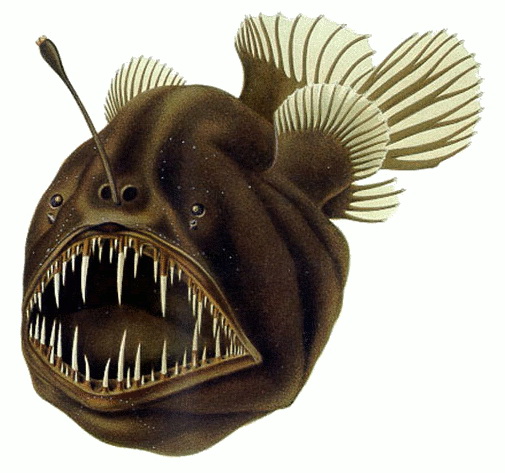Anglerfish (Order: Lophiiformes) - Wiki Anglerfish
From Wikipedia, the free encyclopedia
[Photo] Humpback anglerfish (Melanocetus johnsonii), a species of black seadevil (Melanocetidae). From Brauer, A., 1906. Die Tiefsee-Fische. I. Systematischer Teil.. In C. Chun. Wissenschaftl. Ergebnisse der deutschen Tiefsee-Expedition 'Valdivia', 1898-99. Jena 15:1-432.
Anglerfish are bony fish in the order Lophiiformes, named for their characteristic mode of predation, wherein a fleshy growth from the fish's head (the esca) acts as a lure; this is considered analogous to angling.
Anglerfish are both pelagic and benthic fishes of the abyss (e.g. Ceratiidae) and the continental shelf (e.g. the frogfishes Antennariidae and the monkfish/goosefish Lophiidae) respectively. They occur worldwide. Pelagic forms are most laterally compressed whereas the benthic forms are often extremely dorse-ventrally compressed (depressed) often with large upward pointing mouths.
Predation
The fish are named for their characteristic method of predation. Anglerfish typically have three long filaments sprouting from the middle of the head; these are the detached and modified three first spines of the anterior dorsal fin. In most anglerfish species, the longest filament is the first (the illicium). This first spine protrudes above the fish's eyes, and terminates in an irregular growth of flesh (the esca) at the tip of the spine. The spine is movable in all directions, and the esca can be wiggled so as to resemble a prey animal, and thus to act as bait to lure other predators close enough for the anglerfish to devour them whole. The jaws are triggered in automatic reflex by contact with the tentacle.
Deep sea anglerfish live mainly in the oceans' aphotic zones, where the water is too deep for sufficient sunlight to penetrate for photosynthesis to occur, therefore their predation relies on the "lure" being bioluminescent (via bacterial symbiosis).
The wide mouth extends all around the anterior circumference of the head, and both jaws are armed with bands of long pointed teeth, which are inclined inwards, and can be depressed so as to offer no impediment to an object gliding towards the stomach, but to prevent its escape from the mouth. The anglerfish is able to distend both its jaw and its stomach (its bones are thin and flexible) to enormous size, allowing it to swallow prey up to twice as large as its entire body.
Some benthic (bottom-dwelling) forms have arm-like pectoral fins which the fish use to walk along the ocean floor. The pectoral and ventral fins are so articulated as to perform the functions of feet, enabling the fish to move, or rather to walk, on the bottom of the sea, where it generally hides itself in the sand or amongst seaweed. All around its head and also along the body the skin bears fringed appendages resembling short fronds of seaweed, a structure which, combined with the extraordinary faculty of assimilating the colour of the body to its surroundings, assists this fish greatly in concealing itself in places which it selects on account of the abundance of prey.
Aspects of reproduction
Anglerfishes of the suborder Ceratioidea employ an unusual mating method. Since individuals are presumably locally rare and encounters doubly so, finding a mate is problematic. When scientists first started capturing ceratioid anglerfish, they noticed that all of the specimens were females. These individuals were a few inches in size and almost all of them had what appeared to be parasites attached to them. It turned out that these "parasites" were the remains of male ceratioids.
At birth, male ceratioids are already equipped with extremely well developed olfactory organs that detect scents in the water. They have no digestive system, and thus are unable to feed independently. They must find a female anglerfish, and quickly, or else they will die. The sensitive olfactory organs help the male to detect the pheromones that signal the proximity of a female anglerfish. When he finds a female, he bites into her flank, and releases an enzyme which digests the skin of his mouth and her body, fusing the pair down to the blood vessel level. The male then atrophies into nothing more than a pair of gonads that release sperm in response to hormones in the female's bloodstream indicating egg release. This is an extreme example of sexual dimorphism. However, it ensures that when the female is ready to spawn, she has a mate immediately available.
The spawn of the anglerfish of the genus Lophius consists of a thin sheet of transparent gelatinous material 2 or 3 feet wide and 25 to 30 feet in length. The eggs in this sheet are in a single layer, each in its own little cavity. The spawn is free in the sea. The larvae are free-swimming and have the pelvic fins elongated into filaments. Such an egg sheet is rare in fishes.
Consumption
One family Lophiidae is of commercial interest with fisheries found in the in north-western Europe, eastern North America, Africa and the Far East. In Europe and North America, the tail meat of fish of the genus Lophius (known as goosefish (North America) or monkfish (British Isles)), is widely used in cooking and is often compared to lobster tail in taste and texture. It is therefore sometimes referred to as "poor man's lobster."
The anglerfish is a culinary speciality in certain Asian countries. In Japan, each fish sells for as much as US$150; the liver alone, being a great delicacy, can cost US$100.
Threats
North-west european Lophius sp. are listed by the ICES as "outside safe biological limits."
http://en.wikipedia.org/wiki/Anglerfish
| The text in this page is based on the copyrighted Wikipedia article shown in above URL. It is used under the GNU Free Documentation License. You may redistribute it, verbatim or modified, providing that you comply with the terms of the GFDL. |
